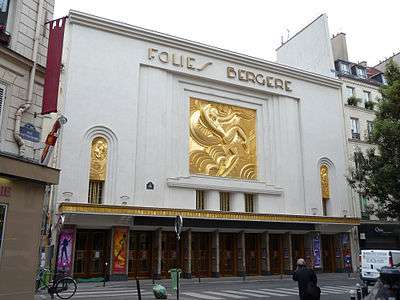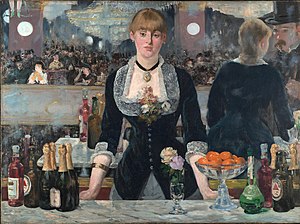Folies Bergère
The Folies Bergère (French pronunciation: [fɔ.li bɛʁ.ʒɛʁ]) is a cabaret music hall, located in Paris, France. Located at 32 rue Richer in the 9th Arrondissement, the Folies Bergère was built as an opera house by the architect Plumeret. It opened on 2 May 1869 as the Folies Trévise, with light entertainment including operettas, comic opera, popular songs, and gymnastics. It became the Folies Bergère on 13 September 1872, named after nearby rue Bergère. The house was at the height of its fame and popularity from the 1890s' Belle Époque through the 1920s.
 2013, after renovation of facade (originally created in 1926) | |
 Folies Bergère Location within France | |
| Address | 32 rue Richer Paris France |
|---|---|
| Coordinates | 48.8742°N 2.3449°E |
| Designation | Cabaret music-hall |
| Construction | |
| Opened | 2 May 1869 |
| Architect | Plumeret |
| Website | |
| Foliesbergere.com | |
Revues featured extravagant costumes, sets and effects, and often nude women. In 1926, Josephine Baker, an African-American expatriate singer, dancer and entertainer, caused a sensation at the Folies Bergère by dancing in a costume consisting of a skirt made of a string of artificial bananas and little else.
The institution is still in business, and is still a strong symbol of French and Parisian life.
History


Located at 32 rue Richer in the 9th Arrondissement, the Folies Bergère was built as an opera house by the architect Plumeret. The métro stations are Cadet and Grands Boulevards.
It opened on 2 May 1869 as the Folies Trévise, with light entertainment including operettas, opéra comique (comic opera), popular songs, and gymnastics. It became the Folies Bergère on 13 September 1872, named after a nearby street, rue Bergère ("bergère" means "shepherdess").[1]
In 1882, Édouard Manet painted his well-known painting A Bar at the Folies-Bergère which depicts a bar-girl, one of the demimondaines, standing before a mirror.
In 1886, Édouard Marchand conceived a new genre of entertainment for the Folies Bergère: the music-hall revue. Women would be the heart of Marchand's concept for the Folies. In the early 1890s, the American dancer Loie Fuller starred at the Folies Bergère. In 1902, illness forced Marchand to leave after 16 years.[2]

In 1918, Paul Derval (1880–1966) made his mark on the revue. His revues featured extravagant costumes, sets and effects, and "small nude women". Derval's small nude women would become the hallmark of the Folies. During his 48 years at the Folies, he launched the careers of many French stars including Maurice Chevalier, Mistinguett, Josephine Baker, Fernandel and many others. In 1926, Josephine Baker, an African-American expatriate singer, dancer and entertainer, caused a sensation at the Folies Bergère in a new revue, La Folie du Jour, in which she danced a number Fatou wearing a costume consisting of a skirt made of a string of artificial bananas and little else. Her erotic dancing and near-nude performances were renowned. The Folies Bergère catered to popular taste. Shows featured elaborate costumes; the women's were frequently revealing, practically leaving them naked, and shows often contained a good deal of nudity. Shows also played up the "exoticness" of persons and objects from other cultures, obliging the Parisian fascination with the négritude of the 1920s.
In 1926 the facade of the theatre was given a complete make-over by the artist Maurice Pico. The facade was redone in Art Deco style, one of the many Parisian theatres of this period using the style.[3]
In 1936, Derval brought Josephine Baker from New York City to lead the revue En Super Folies. Michel Gyarmathy, a young Hungarian arrived from Balassagyarmat, his hometown, designed the poster for En Super Folies, a show starring Josephine Baker in 1936. This began a long love story between Michel Gyarmathy, Paris, the Folies Bergère and the public of the whole world which lasted 56 years. The funeral of Paul Derval was held on 20 May 1966. He was 86 and had reigned supreme over the most celebrated music hall in the world. His wife Antonia, supported by Michel Gyarmathy, succeeded him. In August 1974, the Folies Antonia Derval passed on the direction of the business to Hélène Martini, the empress of the night (25 years earlier she had been a showgirl in the revues). This new mistress of the house reverted to the original concept to maintain the continued existence of the last music hall which remained faithful to the tradition.
Since 2006, the Folies Bergère has presented some musical productions with Stage Entertainment like Cabaret (2006–2008) or Zorro the Musical (2009–2010).
Performers
|
|
Filmography
- 1935: Folies Bergère de Paris directed by Roy Del Ruth, with Maurice Chevalier, Merle Oberon, and Ann Sothern
- 1935: Folies Bergère de Paris directed by Marcel Achard with Maurice Chevalier, Natalie Paley, Fernand Ledoux. A French-language version of the 1935 Hollywood film.
- 1956: Folies-Bergère directed by Henri Decoin with Eddie Constantine, Zizi Jeanmaire, Yves Robert, Pierre Mondy
- 1956: Énigme aux Folies Bergère directed by Jean Mitry with Dora Doll, Claude Godard
- 1991: La Totale! directed by Claude Zidi with Thierry Lhermitte
Similar venues
The Folies Bergère inspired the Ziegfeld Follies in the United States and other similar shows, including a longstanding revue, the Las Vegas Folies Bergere, at the Tropicana Resort & Casino in Las Vegas and the Teatro Follies in Mexico.
In the 1930s and '40s the impresario Clifford C. Fischer staged several Folies Bergere productions in the United States. These included the Folies Bergère of 1939 at the Broadway Theater in New York[4] and the Folies Bergère of 1944 at the Winterland Ballroom[5][6][7] in San Francisco.
The Las Vegas Folies Bergere, which opened in 1959, closed at the end of March 2009 after nearly 50 years in operation.[8][9][10]
A recent example is Faceboyz Folliez, a monthly burlesque and variety show at the Bowery Poetry Club in New York City.[11][12]
In popular culture
- It is the setting for the 1934 ballet Bar aux Folies-Bergère with choreography by Ninette de Valois to music by Chabrier.
- In the musical Nine, the character of Liliane La Fleur sings a song titled "Folies Bergère" in an homage to the Folies Bergère and similar musical acts.
- In the musical Sunday in the Park with George, George promises to take Dot to the Follies.[13]
- In the 1960s British science fiction TV series Captain Scarlet and the Mysterons episode "Model Spy", Colonel White remarks that Cloudbase is an operational base and not the Folies Bergère.
- In the 1960s British science fiction TV series Thunderbirds episode "The Perils of Penelope" Alan Tracy expresses disappointment at not being able to accompany his brothers to "The Folies". Lady Penelope tells him he is too young.
- In Richard Connell's short story "The Most Dangerous Game", General Zaroff "hummed a snatch of song from the 'Folies Bergere'" when referring to the pack of dogs he released to patrol the grounds every night.
- In the 1990s British comedy series Knowing Me Knowing You with Alan Partridge, fictional TV chat show host Alan Partridge's guests and co-presenter attend the Folies Bergere on the evening before the show's live broadcast from Paris. The show's Band Leader, Glen Ponder, is sacked by Partridge live on air for not inviting him on the trip.
See also
Notes
- A Brief History of the Folies-Bergère Art & Architecture
- "Édouard Marchand et les Folies bergère". Webcache.googleusercontent.com. Archived from the original on 26 April 2014. Retrieved 2014-06-09.CS1 maint: BOT: original-url status unknown (link)
- "Paris, the Birthplace of Art Deco". Minor Sights. Retrieved 23 November 2016.
- "Folies Bergère 1939". Playbillvault.com. Archived from the original on 25 December 2014. Retrieved 9 June 2014.
- "Follies Bergere in San Francisco, 1944". News.google.com. 23 November 1943. Retrieved 9 June 2014.
- "Poster, card, and photo from The Folies Bergere of 1944 in San Francisco". Glopad.org. Retrieved 9 June 2014.
- "Berkeley Daily Gazette - Google News Archive Search". news.google.com.
- Prentice, Claire (28 March 2009). "BBC: Folies bows out amid credit crisis". BBC News. Retrieved 9 June 2014.
- "Folies Bergere To Close In Las Vegas". NPR. 23 February 2009. Retrieved 9 June 2014.
- John Palmer. "'Les Folies Bergere' to end run at Tropicana". Las Vegas Sun. Retrieved 9 June 2014.
- "Just Do Art! | The Villager Newspaper". Thevillager.com. Retrieved 9 June 2014.
- Archived 10 March 2012 at the Wayback Machine
- "Jake Gyllenhaal in 'Sunday in the Park With George': EW Stage Review". EW.com.
